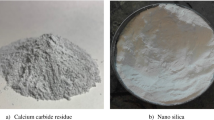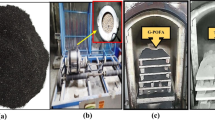Abstract
To minimize the adverse impacts of cement production, introduce a natural resources as replacive cementitious material, and provide sustainable concrete, the present work identified a sub-class of zeolite soil with high SiO2 and low CaO contents, namely “clinoptilolite.” It is a widely spreaded soil, mechanically active, potentially ready to contribute in concrete pozzolanic reactions in a novelty manner. The mechanical activation modified the morphology and the structure of clinoptilolite to amorphous phases (e.g., hydroxyls losing bonding strength). To approach the goals, several dosages of clinoptilolite (0–20%) with and without silica fume (0–10%) contributed to the design of 567 concrete mixes, at three water-to-binder (w/b) ratios of 0.38, 0.42, and 0.45, the mixes were cured for 7, 28 and 90 days. Using the Taguchi L9 orthogonal array, 9 sets of optimum mix designs were derived out of 27 experiments and were optimized for mechanical strength tests. The experimental data and predicted results were compared and validated with a total accuracy of 90.84% (acceptable error levels). By increasing the curing age at the lowest w/b ratio, compressive strength (up to 56 MPa), Tensile strength (up to 3.9 MPa), and flexural strength (up to 7.0 MPa) were enhanced by both replacive materials (up to 30 wt%). However, long-term development (28, 90 days) is characterized by clinoptilolite, indicating a high pozzolanic reactivity in a lower w/b ratio attributable to its specific surface area and reactive SiO2 content. The experimental program and the high accuracy of the model showed that replacing OPC with clinoptilolite and SF is highly recommended in terms of sustainable concrete production, minimizing cement manufacturing impacts, and lowering the water consumption.



















Similar content being viewed by others
References
Vishwakarma V, Ramachandran D (2018) Green concrete mix using solid waste and nanoparticles as alternatives: a review. Constr Build Mater 162:96–103. https://doi.org/10.1016/j.conbuildmat.2017.11.174
Pillai RG et al (2019) Service life and life cycle assessment of reinforced concrete systems with limestone calcined clay cement (LC3). Cem Concr Res 118:111–119. https://doi.org/10.1016/j.cemconres.2018.11.019
Juenger MC et al (2019) Supplementary cementitious materials: New sources, characterization, and performance insights. Cem Concr Res 122:257–273. https://doi.org/10.1016/j.cemconres.2019.05.008
Diaz-Loya I et al (2017) Extending supplementary cementitious material resources: reclaimed and remediated fly ash and natural pozzolans. Cement Concr Compos 101:44–51. https://doi.org/10.1016/j.cemconcomp.2017.06.011
Hedayatinia F et al (2019) Rheological properties, compressive strength and life cycle assessment of self-compacting concrete containing natural pumice pozzolan. Constr Build Mater 206:122–129. https://doi.org/10.1016/J.CONBUILDMAT.2019.02.059
Najimi M, Ghafoori N (2019) Engineering properties of natural pozzolan/slag based alkali-activated concrete. Constr Build Mater 208:46–62. https://doi.org/10.1016/j.conbuildmat.2019.02.107
Pekmezci BY, Akyüz S (2004) Optimum usage of a natural pozzolan for the maximum compressive strength of concrete. Cem Concr Res 34(12):2175–2179. https://doi.org/10.1016/j.cemconres.2004.02.008
Rodrıguez-Camacho R, Uribe-Afif R (2002) Importance of using the natural pozzolans on concrete durability. Cem Concr Res 32(12):1851–1858. https://doi.org/10.1016/S0008-8846(01)00714-1
Celik K et al (2019) Effect of volcanic ash pozzolan or limestone replacement on hydration of Portland cement. Constr Build Mater 197:803–812. https://doi.org/10.1016/j.conbuildmat.2018.11.193
Kashani A et al (2019) Effect of recycled glass fines on mechanical and durability properties of concrete foam in comparison with traditional cementitious fines. Cement Concr Compos. https://doi.org/10.1016/j.cemconcomp.2019.03.004
Küçükyıldırım E, Uzal B (2014) Characteristics of calcined natural zeolites for use in high-performance pozzolan blended cements. Constr Build Mater 73:229–234. https://doi.org/10.1016/j.conbuildmat.2014.09.081
Abdellaoui Y et al (2018) Characterizations and industrial applications for cement and concrete incorporated natural zeolite. Zeol Appl. https://doi.org/10.5772/intechopen.74953
Komarneri S et al (1982) Al-substituted tobermorite: shows cation exchange. Cem Concr Res 12(6):773–780. https://doi.org/10.1016/0008-8846(82)90041-2
Yang J et al (2017) Principles of designing extra-large pore openings and cages in zeolitic imidazolate frameworks. J Am Chem Soc 139(18):6448–6455. https://doi.org/10.1021/jacs.7b02272
Girskas G, Skripkiūnas G (2017) The effect of synthetic zeolite on hardened cement paste microstructure and freeze-thaw durability of concrete. Constr Build Mater 142:117–127. https://doi.org/10.1016/j.conbuildmat.2017.03.056
Mertens G et al (2009) Pozzolanic reactions of common natural zeolites with lime and parameters affecting their reactivity. Cem Concr Res 39(3):233–240. https://doi.org/10.1016/j.cemconres.2008.11.008
Ramezanianpour AA et al (2015) Micro and macro level properties of natural zeolite contained concretes. Constr Build Mater 101:347–358. https://doi.org/10.1016/j.conbuildmat.2015.10.101
Perraki T et al (2003) The effect of natural zeolites on the early hydration of Portland cement. Microporous Mesoporous Mater 61(1–3):205–212. https://doi.org/10.1016/S1387-1811(03)00369-X
Özen S et al (2016) A comprehensive evaluation of sedimentary zeolites from Turkey as pozzolanic addition of cement-and lime-based binders. Constr Build Mater 105:46–61. https://doi.org/10.1016/j.conbuildmat.2015.12.055
Uzal B et al (2010) Pozzolanic activity of clinoptilolite: a comparative study with silica fume, fly ash, and a non-zeolitic natural pozzolan. Cem Concr Res 40(3):398–404. https://doi.org/10.1016/j.cemconres.2009.10.016
Bilim C (2011) Properties of cement mortars containing clinoptilolite as a supplementary cementitious material. Constr Build Mater 25(8):3175–3180. https://doi.org/10.1016/j.conbuildmat.2011.02.006
Seraj S et al (2016) Calcining natural zeolites to improve their effect on cementitious mixture workability. Cem Concr Res 85:102–110. https://doi.org/10.1016/j.cemconres.2016.04.002
Burris LE, Juenger MC (2016) Milling as a pretreatment method for increasing the reactivity of natural zeolites for use as supplementary cementitious materials. Cem Concr Compos 65:163–170. https://doi.org/10.1016/j.cemconcomp.2015.09.008
Zhang J et al (2018) Effective solution for low shrinkage and low permeability of normal strength concrete using calcined zeolite particles. Constr Build Mater 160:57–65. https://doi.org/10.1016/j.conbuildmat.2017.11.029
Marfil S, Maiza P (1993) Zeolite crystallization in Portland cement concrete due to alkali-aggregate reaction. Cem Concr Res 23(6):1283–1288. https://doi.org/10.1016/0008-8846(93)90066-I
Murali G, Fediuk R (2020) A Taguchi approach for study on impact response of ultra-high-performance polypropylene fibrous cementitious composite. J Build Eng 30:101301. https://doi.org/10.1016/j.jobe.2020.101301
Prusty R et al (2015) Nano-engineered concrete using recycled aggregates and nano-silica: Taguchi approach. Adv Concrete Constr 3(4):253–268. https://doi.org/10.12989/acc.2015.3.4.253
ASTM C33 (2013) Standard specification for concrete aggregates, in ASTM International. 2003: Philadelphia, PA. Am J Civ Eng Archit 1(5):103–106, https://doi.org/10.12691/ajcea-1-5-3
ISIRI 389. Specification for PORTLAND cement, 3rd Revision, in 8th edition. 1997. https://doi.org/10.14359/51716937
ASTM C494 (2019) Standard specification for chemical admixtures for concrete. ASTM International. West Conshohocken, PA. https://doi.org/10.1520/C0494_C0494M-19
ISIRI 2930 (2013) Specification for PORTLAND cement, 3rd revision, in 8th edition
Mañosa J, et al (2023) Kaolinite structural modifications induced by mechanical activation. Appl Clay Sci 238(Completed), 106918, https://doi.org/10.1016/j.clay.2023.106918
Bish DL, Boak JM (2001) Clinoptilolite-heulandite nomenclature. Rev Mineral Geochem 45(1):207–216. https://doi.org/10.2138/rmg.2001.45.5
Suraneny P, et al (2021) ASTM C618 fly ash specification: comparison with other specifications, shortcomings, and solutions. ASTM International. 2021: West Conshohocken, PA. 118(1):157–167. https://doi.org/10.14359/51725994
El-Mahdi Safhi A et al (2022) Elaboration of a blended binder based on marls from phosphate mines waste rocks. Constr Build Mater 347:128539. https://doi.org/10.1016/j.conbuildmat.2022.128539
Dolenec S, Ducman V (2018) Evaluation of ash pozzolanic activity by means of the strength activity index test, FFrattini test, and DTA/TG analysis. Tehnički vjesnik 25(6):1746–1752. https://doi.org/10.17559/TV-20171203193229
ASTM C39/C39M-18 (2018) Standard test method for compressive strength of cylindrical concrete specimens, in ASTM International. West Conshohocken, PA. https://doi.org/10.1520/C0039_C0039M-18
Ghafari E et al (2016) Feasibility of using natural SCMs in concrete for infrastructure applications. Constr Build Mater 127:724–732. https://doi.org/10.1016/j.conbuildmat.2016.10.070
ASTM C496/C496M-17 (2017) Standard test method for splitting tensile strength of cylindrical concrete specimens. ASTM International. 2017: West Conshohocken PA. https://doi.org/10.1520/C0496_C0496M-17
ASTM C78/C78M-18 (2018) Standard test method for flexural strength of concrete (using simple beam with third-point loading). West Conshohocken, PA: ASTM International. https://doi.org/10.1520/C0078_C0078M-18
Balamuralikrishnan R, Saravanan J (2021) Effect of addition of alccofine on the compressive strength of cement mortar cubes. Eng Sci J 5(2):155–170. https://doi.org/10.28991/esj-2021-01265
Zou F et al (2022) Performance of zeolite synthesized from sewage sludge ash as a warm mix asphalt additive. Resour Conserv Recycl 181:106254. https://doi.org/10.1016/j.resconrec.2022.106254
Xu G, Shi X (2018) Characteristics and applications of fly ash as a sustainable construction material: a state-of-the-art review. Resour Conserv Recycl 136:95–109. https://doi.org/10.1016/j.resconrec.2018.04.010
Dong W et al (2021) A comprehensive review on the performance of cementitious and geopolymer concretes with recycled waste glass as powder, sand or cullet. Resour Conserv Recycl 172:105664. https://doi.org/10.1016/j.resconrec.2021.105664
Yu J et al (2021) Mechanical, environmental and economic performance of sustainable Grade 45 concrete with ultrahigh-volume Limestone-Calcined Clay (LCC). Resour Conserv Recycl 175:105846. https://doi.org/10.1016/j.resconrec.2021.105846
Alexey V et al (2022) Thermal regeneration and reuse of carbon and glass fibers from waste composites. Eng Sci J 6(5):967–984. https://doi.org/10.28991/ESJ-2022-06-05-04
Iswarya G, Beulah M (2022) Experimental and analytical study of high-strength concrete containing natural zeolite and additives. Civ Eng J 8(10):2318–2335. https://doi.org/10.28991/CEJ-2022-08-10-019
Oussama K et al (2022) Improvement of the mechanical behavior of an environmental concrete based on demolished concrete waste and silica fume. Civ Eng J 8(2):238–250. https://doi.org/10.28991/CEJ-2022-08-02-04
Mazloom M et al (2018) Effects of silica fume, superplasticizer dosage and type of superplasticizer on the properties of normal and self-compacting concrete. Adv Mater Res 7(1):407–434. https://doi.org/10.12989/amr.2018.7.1.407
Funding
This research received no specifc grant from any funding agency in the public, commercial, or not-for-proft sectors.
Author information
Authors and Affiliations
Corresponding author
Ethics declarations
Conflict of interests
The authors have no competing interests to declare that are relevant to the content of this article, including the Beam Gostar Taban Laboratory that is acknowledged because of taking the FE-SEM images.
Ethical approval
This article does not contain any studies with human participants or animals performed by any of the authors.
Informed consent
For this kind of study formal consent is not required.
Rights and permissions
Springer Nature or its licensor (e.g. a society or other partner) holds exclusive rights to this article under a publishing agreement with the author(s) or other rightsholder(s); author self-archiving of the accepted manuscript version of this article is solely governed by the terms of such publishing agreement and applicable law.
About this article
Cite this article
Soltani, A., Tarighat, A., Rostami, R. et al. Investigation of mechanical properties of concrete with clinoptilolite and silica fume using Taguchi method. Innov. Infrastruct. Solut. 9, 77 (2024). https://doi.org/10.1007/s41062-024-01362-3
Received:
Accepted:
Published:
DOI: https://doi.org/10.1007/s41062-024-01362-3




